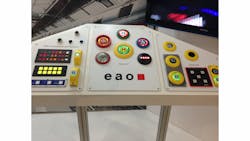EAO is well known for specific HMI components, and in recent years merged into a complete HMI system bringing knowledge and services to new customers that may not have background in button assembly, placement or regulatory requirements.
“We can help them design a whole dashboard and cockpit. We have the component level expertise as well as the ergonomics and the knowledge of the specific industry standards, and we can bring the total integrated solution to the customer,” said Lance Scott, president, EAO Corp.
The company is working with train car builders to develop subassemblies for maintenance, repair and integration. “At one point the car builder would buy individual components and assembly it themselves, but creating integrated systems to provide the customer has been a big focus of EAO in this industry segment,” said John Pannone, VP sales, HMI Systems, EAO Corp.
“We divide our product areas into driver compartment, passenger compartment for the operator of the vehicle, into passenger products that make it intuitive and easy for the passenger to access a door, compartment or other function. We do this through the use of sound and visual indicators for disabled or sensory impaired passengers that may be looking for a ramp request, for example,” Pannone said.
From a passenger’s perspective, EAO Corp. continues to provide the latest in human machine interface (HMI) technology, the Series 57 door-opening pushbuttons that combine optical, tactile and acoustic features in a single product package.
The modern design features an extra-large operating area of 074 mm, including two independently illuminated feedback rings. The raised symbols conform to TSI PRM and ADA and is resistant to wear and fading. Options include illuminated symbols and an integrated ‘finding tone’ to help visually impaired passengers.
The Series 57 used contemporary materials and will continue working through extreme temperatures from -40 to 85 Celsius. The front is protected to IP69K against liquid and dirt ingress, and will resist chemical wash-downs often found within these application environments.
“When the passenger board the train, we want to make indicators easy to understand so the experience of riding the vehicle is a pleasant one,” said Pannone.



